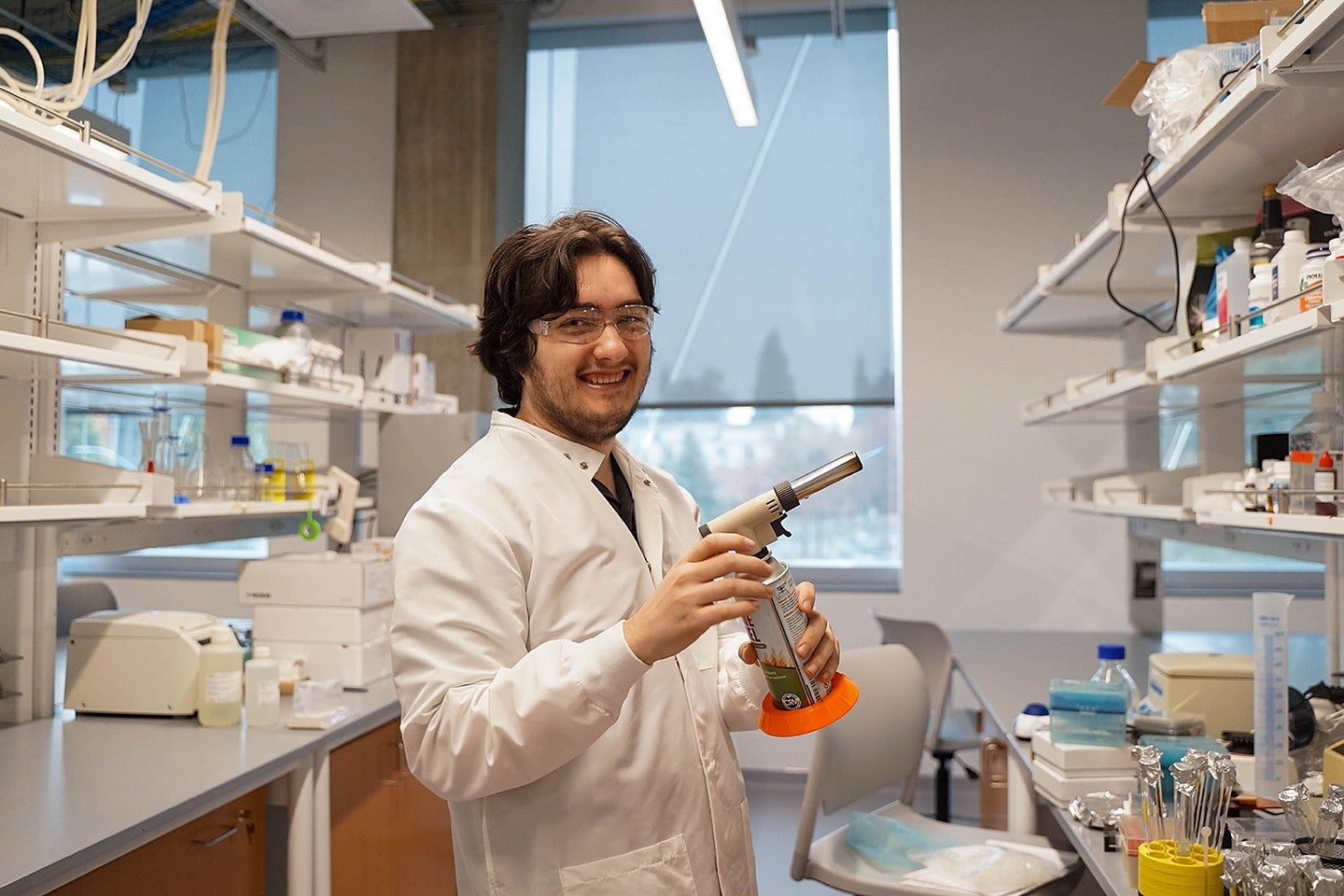
A recipe for innovation

Major: Biochemistry
Coffee or tea: Coffee, 100 percent. Just regular espresso. I like a dried light roast, if I can find it.
Role Model: For a lot of things, Calin Plesa. He really is, to me, the perfect science mentor.
Favorite book: I love the “Culture” series by Iain Banks.
Can't live without: Diet Peach Snapple
Favorite thing about the CHC: The close relationships you form with professors.
Oliver Loreto fondly remembers his time at the Phil and Penny Knight Campus for Accelerating Scientific Impact. It was spring of his freshman year and he had just attended the first meeting for the newly formed UO chapter for the International Genetically Engineered Machine Competition, known as iGEM.The annual competition allows students to engage in synthetic biology research, learn to safely produce a living machine of their own design, and compete at a jamboree against teams from institutions worldwide. What his team lacked in experience, they made up for in passion.
The excitement among the group was palpable, but they faced a significant challenge: They had just a few months to conceive and design a project. Immediately, they started brainstorming, their whiteboard filling up with different problems to solve with biotech solutions. The group landed on the idea of using biomarkers to detect concussions, a common concern among UO’s student-athlete population. After the meeting, Loreto went home and read up on the subject. He searched for any materials he could get his hands on and pondered the potential scope of the project. He wanted to ensure he did his part to help move the team forward.
“It was kind of a magical experience,” Loreto remembers. “That's what got me into synthetic biology in general, and that's what exposed me to what synthetic biology can do for the world.”
Loreto, who would later set his sights on a career in bioengineering, used the experience to develop an understanding of the myriad biochemical tools available. He built a website and developed much of the software for the project. Within months, the group produced concussion-sensing biotechnology that earned a silver medal at the competition and a nomination for the best software tool from an undergraduate team.
“Oliver was one of the most hardworking people on the team,” recalls Calin Plesa, an assistant professor at the Knight Campus and Loreto’s lab advisor who served as the principal investigator for the 2022 iGEM team.
Loreto usually finds himself a step ahead of his peers. He finished his coursework and graduated from the CHC after fall term 2024. He received his biochemistry degree with magna cum laude honors. He was recognized as a finalist for a prestigious 2025 Rhodes Scholarship, and he continues his work as the co-founder of bioengineering startup, ClearMark Biosciences.
The startup produces concussion-detection tests that will cost $20. “It’s cheap to build, and it could really do a lot of good for a lot of people,” Loreto says.
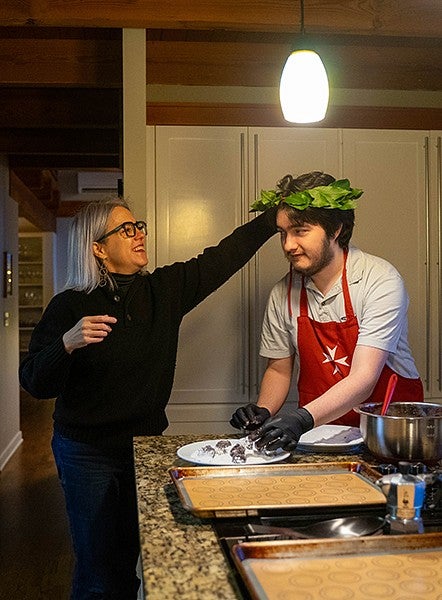
Using French in the kitchen
As a kid, Loreto was influenced by his parents' admiration for cooking. The only child of Andrea Loreto and Kate Mondloch, he remembers helping his parents in the kitchen at an early age. When he was seven, he developed a cookbook under his dad’s supervision. Loreto recalls one recipe for “fresh grapes” where the cook is instructed to place grapes in an ice cube tray and freeze them before snacking. He later graduated to baking cookies, croissants and other fancy fare as he got older.
“My dad is a really good cook, and cooking is a really big deal in our family, so I think it came naturally out of that,” Loreto says.
By high school, Loreto was drawn to science classes. He remembers taking an AP biology course as a sophomore, in which students dissected flowers and built models of the cell. But the project that Loreto remembers best is the one that sparked his affinity for biology.
The class spent a day bioengineering a lab-grown strain of E. coli with a gene naturally found in jellyfish. The experiment caused the E. coli to glow under green light. He remembers being amazed that the project could be completed with simple chemicals accessible in the classroom. “I just put a little bottle of goo in a cold box and then a hot box,” he recalls. “I added some clear stuff, and then it just worked, and that it’s sort of like real-life magic.”
While he spent most of his time developing his fascination for science, he nurtured another passion in a different discipline: French. For years, Loreto had taken French immersion classes. While fluent in the language, he struggled to find a practical application for it that intersected with his interest in science.
That was until he took AP French. It was backtracking for the then-teenage Loreto, who had already taken 300-level courses in French at UO during his freshman year of high school. To receive the certification, he took AP French the following year.
He doesn’t remember being very engaged in what was, at the time, a lower-level class for him. That was until one class assignment where he taught himself how to make croissants. He watched videos of French bakers, relaying their techniques and applying science to his recipes.
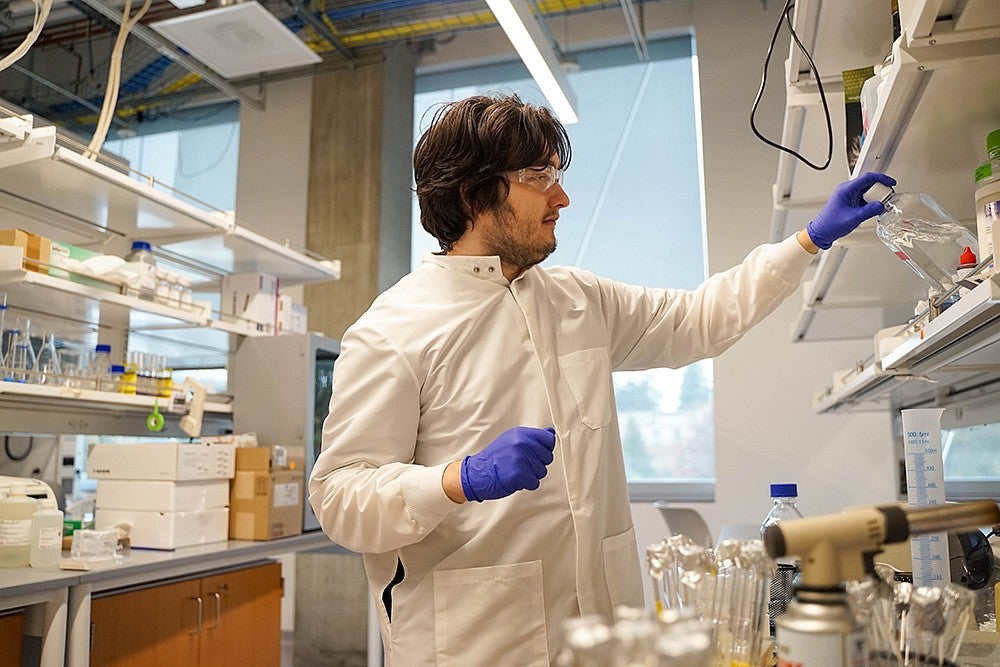
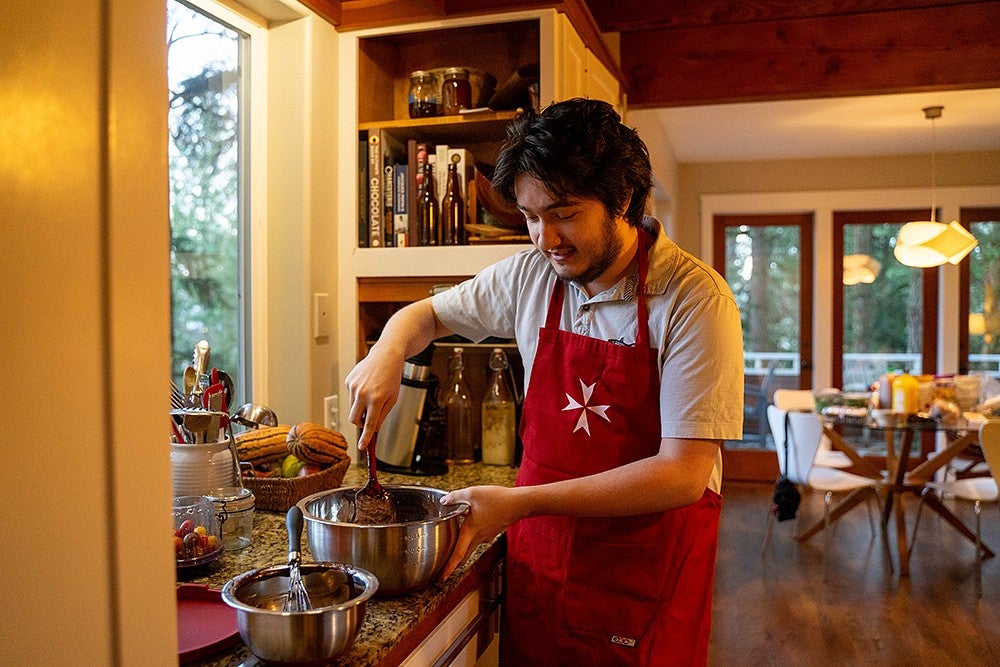
“I see similarities between chemistry and baking, which is what everyone always says: that cooking is an art and baking is chemistry,” he says. “Pretty much anything you bake is just like an organic chemistry synthesis, except baking is easier.”
The theme of baking for classes continued throughout his sophomore year. “I would bribe my AP bio teacher and the entire class with pastries so that they would put up with me asking questions,” Loreto says. He would bring a new treat to each class, always making something from the America’s Test Kitchen app. “People always go wild over lemon bars,” he says, remembering the class’s reaction that day.
Since 2022, he’s been working his way through Patisserie, a French pastry cookbook, plugging away at recipes whenever he has the time. Bookmarked in the pages is a recipe for Palmiers, a sugary, laminated-dough pastry he often makes for his dad.
His mom, Kate Mondloch, a UO professor of contemporary art history and theory at the CHC, says her son has always stayed true to his interests. She remembers that, as a kid, he asked for three magazine subscriptions: New Scientist, Cat Fancy, and Cook’s Illustrated.
Active learning in the lab
When he wasn’t busy with iGEM or working toward a new pastry pursuit, Loreto spent his time in the Plesa Lab as part of the Knight Campus Undergraduate Scholars Program. His current project involves tricky work with receptor histidine kinases, tiny sensors many organisms use to detect the world around them. “His task was a pretty difficult one,” Plesa says. “It was to try to leverage computational methods to try to predict which chemicals might be responsible for activating certain receptors.”
There are over 18 million histidine kinase receptors in nature. These tiny sensors can detect almost anything from color and light to the presence of certain chemicals. Loreto’s work used computer software to see if the relationships of these kinase receptor sensors can be reproduced. In theory, it would allow scientists to use these receptor sensors to detect lead in water or microplastics in fish, for example.
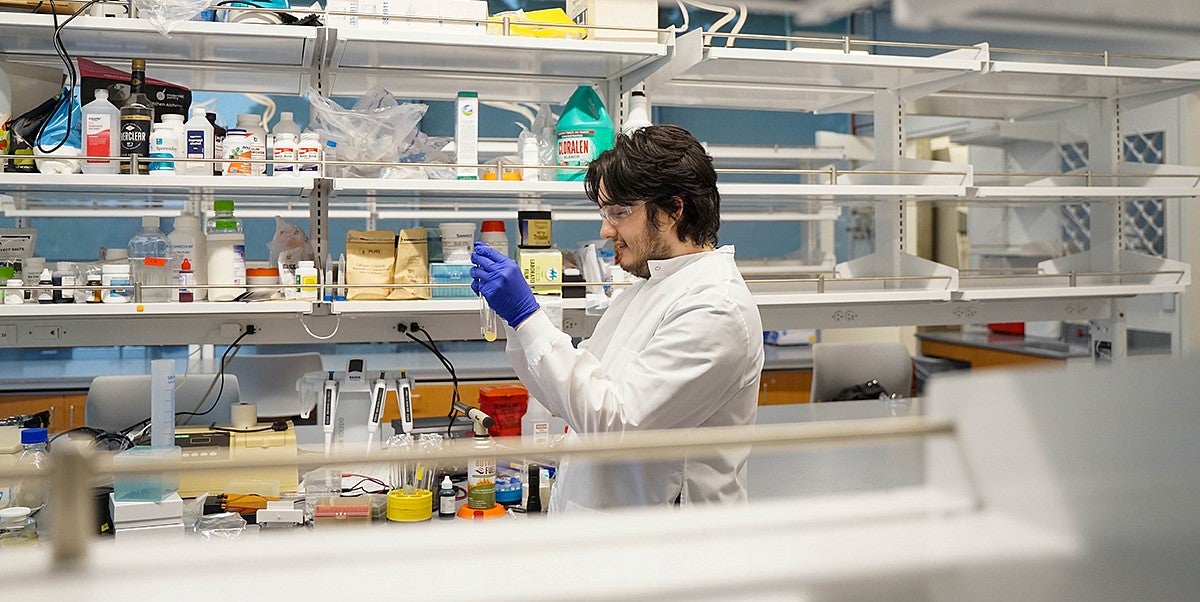
Plesa says Loreto was highly persistent with his work, trying dozens of programs to determine what would be successful. He could go for months before having a breakthrough moment with a legitimate signal from a sensor. “He's really in tune and up to date with the latest developments in our area,” Plesa says. “It's nice to see that in an undergrad.”
Today, Loreto can call himself a graduate of the Clark Honors College. He defended his thesis last term, presenting a business plan for ClearMark, his biotech company. His thesis showcased a framework for moving his company from the development stage to something that can take on investors. Now that he’s finished with school, he’s continuing the development of the technology for ClearMark in his Eugene garage, beginning “like all the best startups do,” he says.
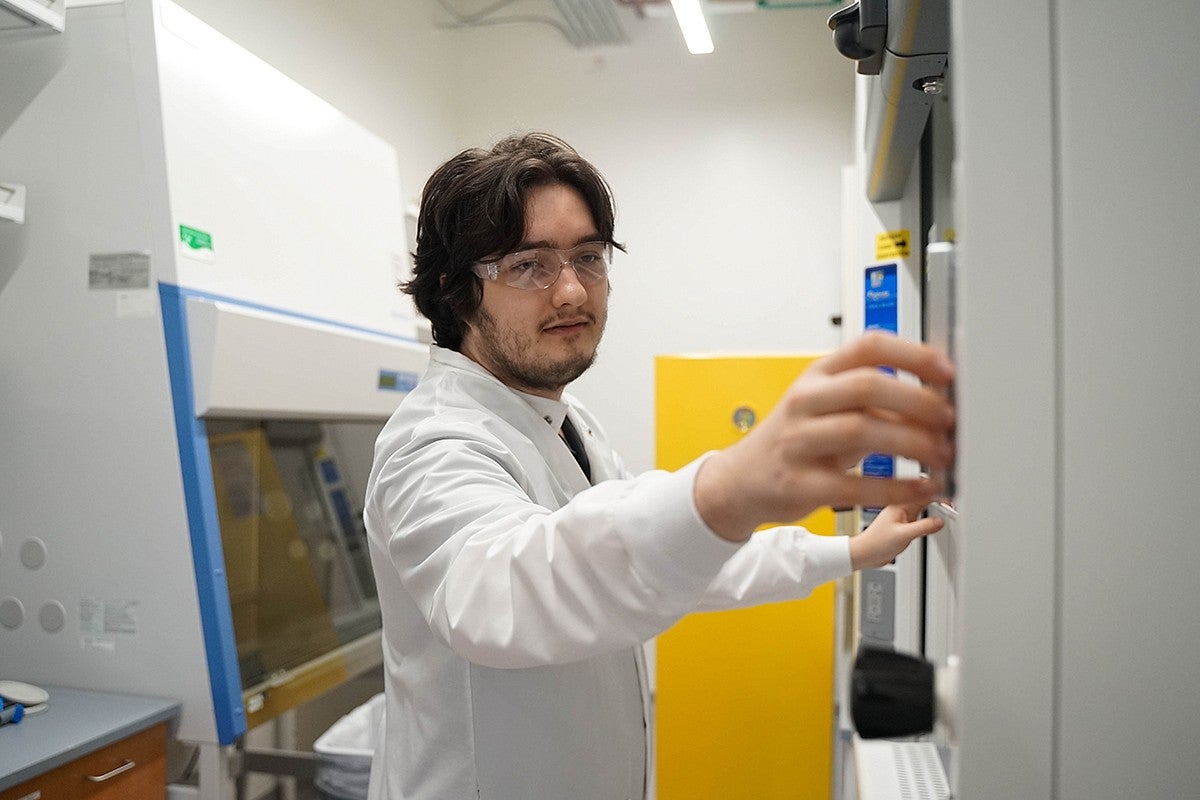
He still needs to get approval for his product from the federal Food and Drug Administration. Once he does, he says, he wants to get the technology out there for the people who need it most. He envisions his product being a part of first-aid kits at schools and beyond. He also plans to market it with the potential for home delivery.
“Early detection of concussions could save thousands of lives,” he says. “We just don’t have a good way to do that right now.”
